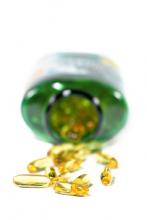High levels of vitamin D in the bloodstream may help protect against early age-related macular degeneration (AMD) in women younger than 75 years, according to the latest findings from the Carotenoids in Age-Related Eye Disease Study (CAREDS), a study to investigate the relationship of carotenoids in the diet, serum and retina to AMD and cataract.
These findings, published in the April 2011 issue of Archives of Ophthalmology, confirm those of an earlier cross-sectional study that showed a strong protective association between serum concentrations of 25-hydroxyvitamin D, or 25(OH)D, and the prevalence of early AMD. Serum 25(OH)D reflects vitamin D exposure from oral sources and sunlight, making it the preferred biomarker for determining a patient’s vitamin D status.
Amy E. Millen, Ph.D., of the State University of New York at Buffalo and her colleagues wanted to confirm the protective effect of vitamin D among CAREDS subjects.
CAREDS, an ancillary study within the Women’s Health Initiative Observational Study (WHIOS), comprises women aged 50-79 years from 3 of the 40 WHIOS sites. Researchers initially recruited 3,143 women from the WHIOS for this analysis, but after accounting for those who declined to participate or were excluded for other reasons, the final sample consisted of 1,313 women (Arch. Ophthalmol. 2011;129:481-9).
Researchers obtained baseline serum samples between 1993 and 1998, an average of 6 years before the onset of early AMD. They also had participants complete a food frequency questionnaire at WHIOS baseline to assess vitamin D intake from foods and supplements; and asked participants at CAREDS baseline to report sunlight exposure for each city/town in which they lived from age 18 years to the present. Researchers determined AMD status based on stereoscopic fundus photos taken between 2001 and 2004.
After the researchers adjusted for age and other known risk factors for AMD, they found no significant overall relationship between vitamin D status and early or advanced AMD. However, women younger than 75 years who had 25(OH)D concentrations higher than 38 nmol/L, had a significant 48% decreased odds of early AMD, which researchers defined as more than one large drusen, extensive intermediate drusen, or pigmentary abnormalities.
Women who consumed the most vitamin D (food or supplements) had a 59% decreased odds of developing early AMD, compared with women who consumed the least vitamin D. The researchers found no relationship between self-reported time spent in direct sunlight and early AMD.
In women older than 75 years, higher concentrations of 25(OH)D were associated with a borderline statistically significant increased risk of early AMD. This latter finding is likely because of selective mortality bias, according to the researchers.
Vitamin D has both anti-inflammatory and immune-modulating properties, and might suppress the inflammatory cascade that is likely involved in the pathogenesis of AMD, the researchers stated. Vitamin D also may prevent early AMD from progressing to the neovascular form.
"Our data support the previous observation that vitamin D status may potentially protect against development of AMD," the authors concluded.
Limitations of the study included the fact that 36% of eligible subjects declined to participate, those younger than age 75 years had healthier diet and lifestyles, and there was limited minority participation, so selection bias may have occurred, the researchers say.
More longitudinal studies are necessary to confirm this association and to understand the potential interaction between vitamin D status and genetic and lifestyle factors with respect to the risk of early AMD, the authors added.
One of the coauthors is a consultant for Sequenom, a life sciences company. There were no other pertinent disclosures. The National Institutes of Health and Research to Prevent Blindness provided grants. WHIOS is funded by the National Heart, Lung, and Blood Institute, National Institutes of Health, and U.S. Department of Health and Human Services.


